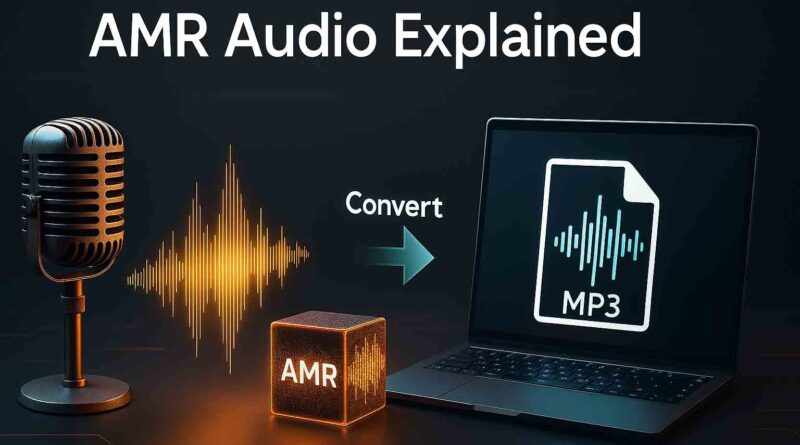What Is An AMR File and How Do I Open It
What Is an AMR File?
An AMR (Adaptive Multi-Rate) file is an audio compression format specifically optimized for speech coding. Developed originally by Ericsson and standardized by the 3GPP (3rd Generation Partnership Project) in 1999, it became the standard codec for voice recordings in GSM and UMTS mobile networks. If you’ve ever received a voice message from an older mobile phone, especially from a Nokia device, or created a voice memo on your phone, there’s a good chance it was saved as an AMR file (with the .amr extension).
The primary purpose of AMR is to efficiently compress human speech, making file sizes very small while maintaining acceptable voice clarity. It achieves this through a sophisticated algorithm called Algebraic Code Excited Linear Prediction (ACELP). The “Adaptive Multi-Rate” name refers to its ability to dynamically switch between different bit rates based on network conditions, prioritizing voice clarity when possible and connection stability when bandwidth is limited.
Key Technical Specifications
For those interested in the technical details, here are the core specifications of the AMR-NB (Narrowband) codec:
AMR also comes in a Wideband version called AMR-WB, which uses a 16 kHz sampling rate for improved voice quality and a more natural sound, often identified by the .awb file extension.
AMR vs. MP3 and Other Modern Codecs
Understanding how AMR stacks up against more common audio formats like MP3 is key to knowing its proper use.
AMR vs. MP3: A Detailed Comparison
The table below outlines the fundamental differences:
Pros and Cons of AMR Files
Advantages:
- Extremely Small File Size: Its most significant benefit. AMR compression creates very small files, perfect for storage-limited environments or sending over weak network signals.
- Bandwidth Adaptation: Dynamically adjusts bit rate to maintain a stable connection under varying network conditions, a key reason for its adoption in mobile telephony.
- Efficiency for Speech: For voice-only content, it provides the best clarity-per-bit ratio compared to general-purpose codecs.
Disadvantages:
- Poor for Music and Complex Sounds: Due to its narrowband frequency response, AMR is terrible for music or any audio other than speech, resulting in a “tinny” sound.
- Limited Compatibility: While universally supported on mobile devices, most desktop media players cannot play AMR files natively, requiring conversion or special software.
- No Digital Rights Management (DRM): Lacks support for copyright protection features.
How to Open and Play AMR Files
You can successfully play AMR files on almost any device using the right software. Below is a guide to the most reliable and widely available players.
On Desktop (Windows & Mac)
- VLC Media Player: The most recommended solution. This free, open-source player can handle AMR files on Windows, Mac, and Linux without needing additional codecs. Simply drag and drop your .amr file into the VLC window.
- 5KPlayer: A versatile free media player that supports AMR playback and includes additional features like a built-in converter and the ability to download online videos.
- Audacity: The free, open-source audio editor can import and play AMR files, but may require you to install a separate FFmpeg library for full format support.
- QuickTime Player (Mac): Can play AMR files, but may require installing an additional codec from Apple’s website or a third party.
Note on Windows Media Player: By default, Windows Media Player does not support AMR files. You would need to install a third-party codec pack, but using VLC is generally a safer and easier option.
On Mobile Devices (Android & iOS)
- Android: Most modern Android devices can play AMR files natively in their built-in voice recorder or music player apps. If you have trouble, try VLC for Android or MX Player.
- iPhone/iOS: Apple’s iOS does not natively support AMR playback. To open an AMR file on an iPhone or iPad, you will need a third-party app like VLC for Mobile, nPlayer, or OPlayer.
Read Also: Adobe Premiere Pro vs Final Cut Pro
How to Convert AMR Files
Since AMR files are not widely compatible and are poor for music, a common solution is to convert them to a universal format like MP3 or WAV.
Method 1: Using Desktop Software (Recommended for Quality and Control)
For the best results, especially with multiple files, dedicated desktop software is the way to go.
- Wondershare UniConverter: A user-friendly tool that can batch convert AMR files to MP3 and many other formats quickly while offering control over output quality (e.g., 128, 256, or 320 kbps).
- Audacity: Use the free Audacity to import the AMR file and then export it in your preferred format like MP3 or WAV. This method gives you full control over audio settings and allows for editing before conversion.
- VLC Media Player: VLC’s conversion feature provides a free built-in option.
Method 2: Using Online Converters (Most Convenient)
For a quick, one-off conversion without installing software, online tools are ideal.
- CloudConvert, Zamzar, Convertio: These are reliable, browser-based converters. The process is simple: upload your .amr file, choose MP3 or WAV as the target format, and download the converted file.
A Word of Caution: Online services involve uploading your audio to a server. Avoid using them for sensitive or confidential recordings. Also, free tiers often have file size limits and may be slower.
Method 3: Using Mobile Apps
Apps like The Audio Converter (Android) can convert AMR files directly on your phone, which is useful for on-the-go tasks.
As this guide has shown, the AMR file is a highly specialized, legacy format that remains relevant due to its incredible efficiency with voice. While you are unlikely to use it for creating new music or podcast content, understanding it is essential for dealing with old voice recordings and understanding the foundations of modern audio communication. I hope this resource has empowered you to confidently manage, play, and convert these files.

